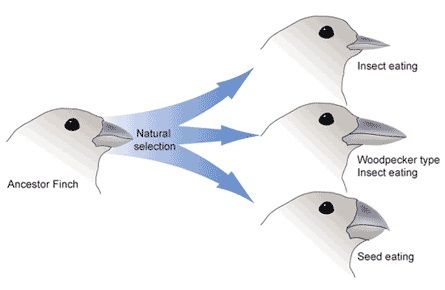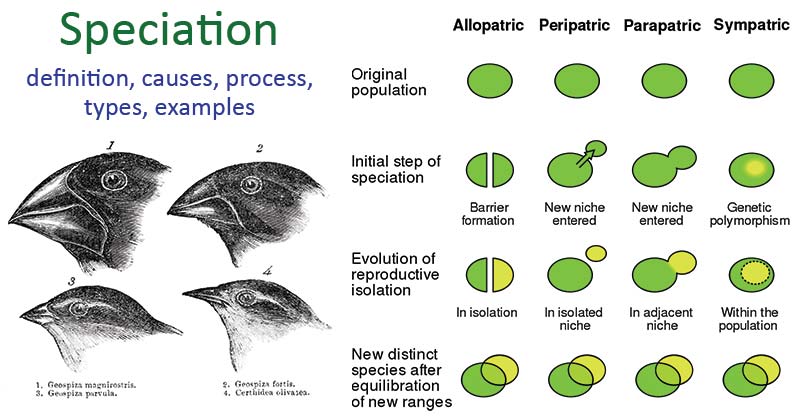Speciation Study Guide
Introduction:
A species is a collection of organisms that can breed with one another and generate viable offspring while remaining reproductively separated from other creatures. This process is known as speciation. Therefore, let’s learn about speciation in detail.
Key points on speciation:
- Speciation is the process of dividing a genetically homogeneous population into two or more populations, each of which undergoes genetic differentiation and eventually reproductive isolation.
- The creation of new populations (species) with better adaptive efficiency than their predecessors determines the trajectory of evolution.
Speciation can take place in two ways:
- Over time, existing species are transformed into new ones
- Multiplication of species is the splitting of a single species into multiple
Rate of evolution:
- Punctuated equilibrium is when evolution occurs rapidly after a long period of stasis.
- Gradualism is when evolution occurs slowly over hundreds of thousands or millions of years.
Process of speciation:
Speciation has traditionally been thought to be a three-stage process:
- Population isolation
- Separated populations’ trait divergence
- Reproductive isolation of populations keeps them apart when they come into touch again (secondary contact)
Types of speciation:
Allopatric speciation:
- The process of speciation in which the original population is separated by a barrier, resulting in reproductive isolation, is known as allopatric speciation.
- It is founded on the notion that new species emerge when a physical geographic barrier splits a species’ big population into two or more tiny populations.
- Because of their physical isolation, these isolated groups are unable to interbreed.
- Physical isolation can be caused by physical obstacles such as extensive ocean stretches, steep mountains, glaciers, deep river valleys, wide rivers, deserts, or a significant distance due to a greater geographical range.
- Each isolated population begins to adapt to its environment, collecting distinctions and developing into new species on its own.
Example of allopatric speciation:
Squirrels that parted off during the creation of the Grand Canyon, resulting in two distinct squirrel species.
Sympatric speciation:
- The development of new species from an initial population that is not geographically separated is known as sympatric speciation.
- It is based on the development of new populations of a species in distinct ecological niches and the reproductive isolation of the new population’s founders from the individuals of the parent population.
- Individuals pursuing a new niche may experience less gene flow than those pursuing a different niche.
- When herbivore insects begin eating and reproducing on a new plant or when a new plant is established within the species’ geographical range, this mechanism of speciation is prevalent.
- The gene flow between species that specialize in a specific plant is thus decreased, potentially leading to new species.
Examples of sympatric speciation:
The North American apple maggot fly is a classic example. As their name indicates, North American apple maggot flies may eat and mate on apple trees. On the other hand, the hawthorn tree was the initial host plant of these insects. It wasn’t until around 200 years ago, when European settlers planted apple trees, that certain flies in the population began to use apples as a food source instead.
Conclusion:
- Speciation is an evolutionary process that results in the emergence of a new species.
- Allopatric, Peripatric, Parapatric, and sympatric are the four geographic modalities of speciation in nature, depending on the extent to which speciating populations are secluded from each other.
- The process of speciation in which the original population is separated by a barrier, resulting in reproductive isolation, is known as allopatric speciation.
- The development of new species from an initial population that is not geographically separated is known as sympatric speciation.
FAQs:
1. What speciation means?
Speciation is the process of creating new species from pre-existing ones. It is an evolutionary process in which genetic changes lead to the evolution of a species. 2. What is the process of speciation?
Speciation has traditionally been thought to be a three-stage process:
- Population isolation
- Separated populations’ trait divergence
- Reproductive isolation of populations keeps them apart when they come into touch again (secondary contact)
3. What is a speciation analogy?
Speciation is the transformation of one species into another over time. This can result in similar structures in various species occupying the same niche and environment in different places.
4. What causes speciation?
Geographic isolation, according to scientists, is a frequent method for the speciation process to begin: rivers change channels, mountains rise, continents shift, creatures migrate, and what was once a single population is split into two or smaller groups.
We hope you enjoyed studying this lesson and learned something cool about Speciation! Join our Discord community to get any questions you may have answered and to engage with other students just like you! Don’t forget to download our App to experience our fun, VR classrooms – we promise, it makes studying much more fun! 😎
Sources:
- speciation. https://www.nature.com/scitable/definition/speciation-183/. Accessed 27 Dec, 2021.
- speciation. https://www.britannica.com/science/speciation. Accessed 27 Dec, 2021.
- Speciation. https://www.nationalgeographic.org/encyclopedia/speciation/. Accessed 27 Dec, 2021.



